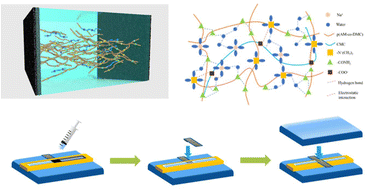A hydrogel electrolyte based on the inhibitory activity of water for in situ supercapacitors†
Abstract
Hydrogel-based supercapacitors have attracted increasing attention owing to their advantages of safety and flexibility. However, the commercialization of supercapacitors based on hydrogels is limited by their low operating voltage attributed to the electrolytic voltage of water. Hence enhancing the operating voltage becomes a fascinating and challenging subject. Meanwhile, lower internal resistance is significant for enhancing specific capacitance. In this work, flexible supercapacitors were fabricated by in situ polymerization of a hydrogel precursor solution containing cationic monomers and anionic polysaccharides between two electrodes. The specific capacitance of the obtained flexible supercapacitor was enhanced efficiently (65.42 F g−1 at a current density of 1 A g−1) while the electrochemical stability window was widened simultaneously to be 1.2 V. The device delivers a maximum energy density of 13.08 W h kg−1 at a power density of 1426.91 W kg−1. At the same time, the poor interfacial adhesion can be successfully overcome under bending and the device can retain 112.70% of capacitance in the flat state. The device exhibits excellent cycling stability, and the capacitance can remain 91.04% after 5000 charge–discharge cycles. This work may be fascinating for constructing flexible energy storage devices with stable structures and outstanding electrochemical performance.



 Please wait while we load your content...
Please wait while we load your content...